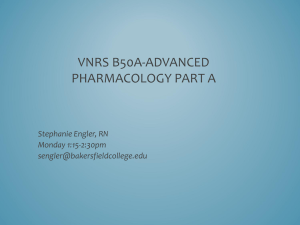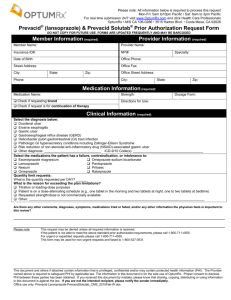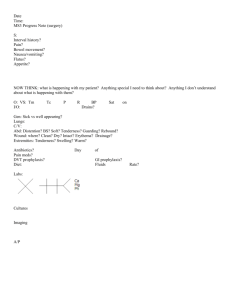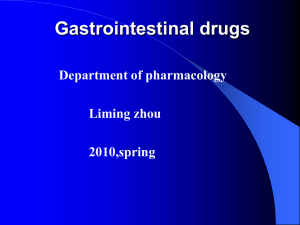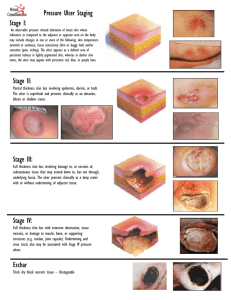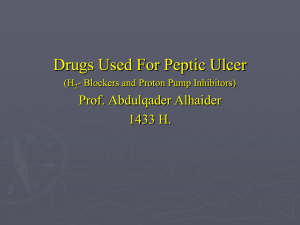Document 13310346
advertisement
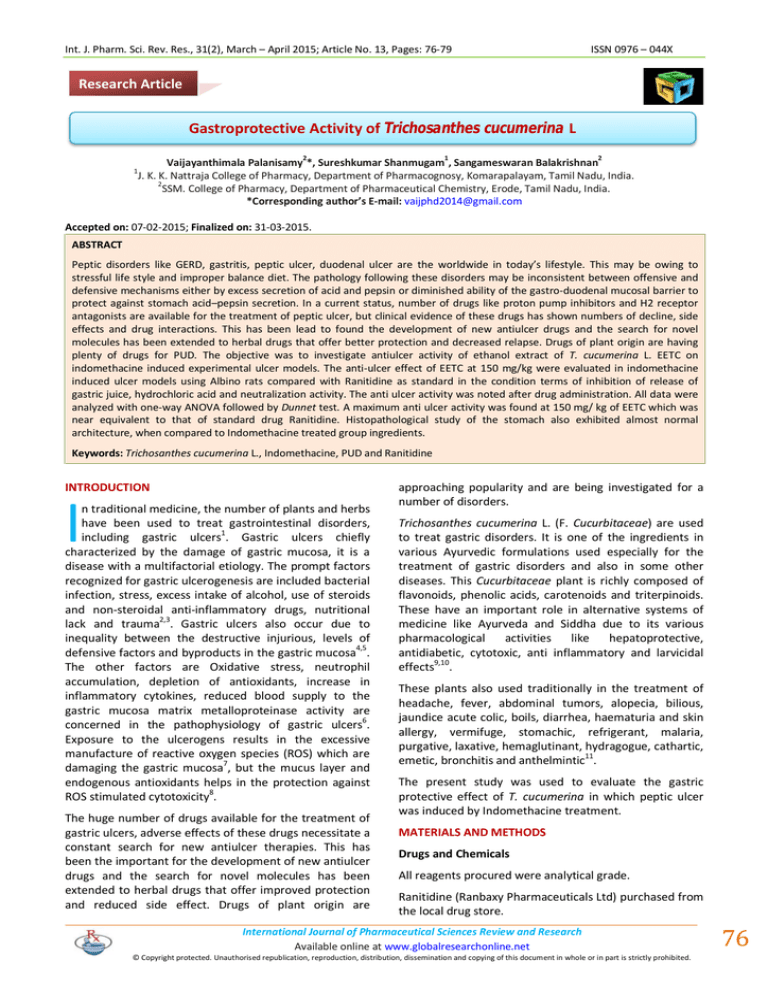
Int. J. Pharm. Sci. Rev. Res., 31(2), March – April 2015; Article No. 13, Pages: 76-79 ISSN 0976 – 044X Research Article Gastroprotective Activity of Trichosanthes cucumerina L 2 1 1 2 Vaijayanthimala Palanisamy *, Sureshkumar Shanmugam , Sangameswaran Balakrishnan J. K. K. Nattraja College of Pharmacy, Department of Pharmacognosy, Komarapalayam, Tamil Nadu, India. 2 SSM. College of Pharmacy, Department of Pharmaceutical Chemistry, Erode, Tamil Nadu, India. *Corresponding author’s E-mail: vaijphd2014@gmail.com Accepted on: 07-02-2015; Finalized on: 31-03-2015. ABSTRACT Peptic disorders like GERD, gastritis, peptic ulcer, duodenal ulcer are the worldwide in today’s lifestyle. This may be owing to stressful life style and improper balance diet. The pathology following these disorders may be inconsistent between offensive and defensive mechanisms either by excess secretion of acid and pepsin or diminished ability of the gastro-duodenal mucosal barrier to protect against stomach acid–pepsin secretion. In a current status, number of drugs like proton pump inhibitors and H2 receptor antagonists are available for the treatment of peptic ulcer, but clinical evidence of these drugs has shown numbers of decline, side effects and drug interactions. This has been lead to found the development of new antiulcer drugs and the search for novel molecules has been extended to herbal drugs that offer better protection and decreased relapse. Drugs of plant origin are having plenty of drugs for PUD. The objective was to investigate antiulcer activity of ethanol extract of T. cucumerina L. EETC on indomethacine induced experimental ulcer models. The anti-ulcer effect of EETC at 150 mg/kg were evaluated in indomethacine induced ulcer models using Albino rats compared with Ranitidine as standard in the condition terms of inhibition of release of gastric juice, hydrochloric acid and neutralization activity. The anti ulcer activity was noted after drug administration. All data were analyzed with one-way ANOVA followed by Dunnet test. A maximum anti ulcer activity was found at 150 mg/ kg of EETC which was near equivalent to that of standard drug Ranitidine. Histopathological study of the stomach also exhibited almost normal architecture, when compared to Indomethacine treated group ingredients. Keywords: Trichosanthes cucumerina L., Indomethacine, PUD and Ranitidine INTRODUCTION I n traditional medicine, the number of plants and herbs have been used to treat gastrointestinal disorders, including gastric ulcers1. Gastric ulcers chiefly characterized by the damage of gastric mucosa, it is a disease with a multifactorial etiology. The prompt factors recognized for gastric ulcerogenesis are included bacterial infection, stress, excess intake of alcohol, use of steroids and non-steroidal anti-inflammatory drugs, nutritional lack and trauma2,3. Gastric ulcers also occur due to inequality between the destructive injurious, levels of 4,5 defensive factors and byproducts in the gastric mucosa . The other factors are Oxidative stress, neutrophil accumulation, depletion of antioxidants, increase in inflammatory cytokines, reduced blood supply to the gastric mucosa matrix metalloproteinase activity are 6 concerned in the pathophysiology of gastric ulcers . Exposure to the ulcerogens results in the excessive manufacture of reactive oxygen species (ROS) which are damaging the gastric mucosa7, but the mucus layer and endogenous antioxidants helps in the protection against ROS stimulated cytotoxicity8. The huge number of drugs available for the treatment of gastric ulcers, adverse effects of these drugs necessitate a constant search for new antiulcer therapies. This has been the important for the development of new antiulcer drugs and the search for novel molecules has been extended to herbal drugs that offer improved protection and reduced side effect. Drugs of plant origin are approaching popularity and are being investigated for a number of disorders. Trichosanthes cucumerina L. (F. Cucurbitaceae) are used to treat gastric disorders. It is one of the ingredients in various Ayurvedic formulations used especially for the treatment of gastric disorders and also in some other diseases. This Cucurbitaceae plant is richly composed of flavonoids, phenolic acids, carotenoids and triterpinoids. These have an important role in alternative systems of medicine like Ayurveda and Siddha due to its various pharmacological activities like hepatoprotective, antidiabetic, cytotoxic, anti inflammatory and larvicidal effects9,10. These plants also used traditionally in the treatment of headache, fever, abdominal tumors, alopecia, bilious, jaundice acute colic, boils, diarrhea, haematuria and skin allergy, vermifuge, stomachic, refrigerant, malaria, purgative, laxative, hemaglutinant, hydragogue, cathartic, 11 emetic, bronchitis and anthelmintic . The present study was used to evaluate the gastric protective effect of T. cucumerina in which peptic ulcer was induced by Indomethacine treatment. MATERIALS AND METHODS Drugs and Chemicals All reagents procured were analytical grade. Ranitidine (Ranbaxy Pharmaceuticals Ltd) purchased from the local drug store. International Journal of Pharmaceutical Sciences Review and Research Available online at www.globalresearchonline.net © Copyright protected. Unauthorised republication, reproduction, distribution, dissemination and copying of this document in whole or in part is strictly prohibited. 76 © Copyright pro Int. J. Pharm. Sci. Rev. Res., 31(2), March – April 2015; Article No. 13, Pages: 76-79 Plant Collection Fresh leaves of T. cucumerina L., was collected from field of Komarapalayam and authenticated by Dr. P. Satyanarayana, Scientist D & Head office in charge, Southern Regional Centre, TNAU campus, Coimbatore. Voucher specimen (No: JKKNCP/0102/12) has been deposited in the Department of Pharmacognosy, JKK Nataraja College of Pharmacy, Komarapalayam, Tamilnadu, India. Preparation of Plant Extracts The dried leaves of T. cucumerina were extracted with Pet ether and then ethanol was subjected to solvent extraction. Ethanol Extract of Cucumerina Linn (EETC) Fine powdered Leaves of T. cucumerina were extracted with ethanol (60-80°) using soxhlet apparatus. The extract was filtered and evaporated to separate solvent and residue. The semisolid residue which obtained was stored in desiccator until further use. ISSN 0976 – 044X Group 3 - Receives Rantidine (100 mg/kg) as a standard reference drug (Std). Group 4 - Receives EETC (150 mg/kg) once daily. Group-2 and Group-4 receives Indomethacine (25 mg/kg) as a single dose for 3 days as an ulcerative agent 1 hour before the ulcerogenic procedures. The animals were sacrificed 6 hr. after the administration of necrotizing agent. The stomachs were removed and opened along with the greater curvature of the stomach; the ulcer index was evaluated according to severity and scored microscopically with the help of a hand lens (10x) as 13-15 follows . Scoring of Ulcer16 0 = Normal colored stomach, 0.5 = Red coloration, 1 = Spot ulcers, 1.5 = Haemorrhaegic streaks, Animals Albino rats either sex weighing between 175 ± 25gm was used in this evaluation. These rats aged between 2 - 2.5 months were procured from animal house located in JKK Nataraja College of Pharmacy, Komarapalayam. They were housed in well ventilated stainless-steel cages at room temperature (24 ± 2°) in hygienic condition under natural light and dark schedule and were fed on a standard laboratory diet. Food and water were given ad libitum. Experimental Protocol 2 = Ulcer > 3mm but < 5mm, 3 = Ulcers > 5mm Calculation of Ulcer Index17 U1 = UN + US + UP x 10-1 U1 = Ulcer Index UN = Average of number of ulcer per animal US = Average of severity score UP = Percentage of animal with ulcer Acute Oral Toxicity Study Determination of Acidity: The acute oral toxicity study was followed by using OECD GUIDELINES - 423 (Organization of Economic Cooperation and Development) - Fixed dose procedure (FDP)12. Acute toxicity study was performed for ethanol extract of T. cucumerina L. (EETC) according to the acute toxic classic method as per OECD (423) guidelines12, albino rats were used for acute toxicity study. The animals were kept in fasting condition for overnight providing only water, then the extract was administered orally at the doses of 5, 50, 300 and 2000 mg/kg and observed for 16 days. If death was observed in 2 out of 3 animals, then the dose administered was concluded as toxic dose. Animals aren’t shown signs of toxicity including mortality; nature, severity, and duration of effects up to the dose level of 2000 mg/kg of the extract. Antiulcer Activity Group 1 - Normal control rats, which received distilled, water (1 ml/kg) orally. Group 2 - Receives Indomethacine (25 mg/kg) as a single dose for 3 days. × 0.1 = × 100 Determination of Percentage Protection: % – = × 100 In the present study, evaluated for EETC anti-ulcer activity 18 against Indomethacine induced gastric ulcer model . The results of study are tabulated in Table 1. Histopathological Studies The stomach from all groups were removed quickly, opened along the greater curvature, and thoroughly rinsed with ice-cold saline. After recording the ulcers produced in the stomach, a section of the gastric tissue was taken from the anterior part of the stomach and kept in a 10% formalin solution. After 24 h of fixation the tissues are embedded in a paraffin block, it was cut into sections of 5 microns onto a glass slide and stained with hematoxylin-eosin for histological assessment of the gastric mucosa (Figure 1-4). International Journal of Pharmaceutical Sciences Review and Research Available online at www.globalresearchonline.net © Copyright protected. Unauthorised republication, reproduction, distribution, dissemination and copying of this document in whole or in part is strictly prohibited. 77 © Copyright pro Int. J. Pharm. Sci. Rev. Res., 31(2), March – April 2015; Article No. 13, Pages: 76-79 ISSN 0976 – 044X Table 1: Effect of EETC and Ranitidine on Indomethacin-induced gastric lesions Gr No. Body wt. gms Treatment group Vol. of Gastric Juice (ml) Free Acidity (Eq/I) 100gm Total Acidity (Eq/I) 100gm Ph 1 175 25 control 1.2 0.71 33.66 3.14 42.33 3.14 7.33 0.33 2 175 25 Ulcer Control Indomethacine 25mg/kg 10.1 2.39** 83.16 6.6** 104 6.16** 2.55 0.32** 3 175 25 Ranitidine 100mg/kg 2.28 0.64† 36 7.63† 45 2.60† 7.4 0.36† 4 175 25 EETC 150mg/kg. 4.33 0.64† 50.16 8.87† 53.6 7.63† 5.13 0.58† Values are expressed as mean ± S.D. of six animals in each group. Statistical analysis ANOVA followed by Dunnett t-test. N= 6 *P < 0.01 as compared with control, †P < 0.01 as compared with standard, ns = non significant. Histopathology of Stomach Fragment Figure 1: GROUP – I(control ) Figure 2: GROUP - II (indomethacine induced) The phytochemical studies carry out in the present study established that Cucurbitaceae family plants contain carbohydrates, flavonoids, sterols, glycosides, saponins, alkaloids, phenols, gums, terpenoids, and mucilage. Among these secondary compounds like terpenoids, saponins, and flavonoids are accounted as antique compounds. Triterpenoids are a widespread class of secondary compounds with several pharmacological activities, anti-inflammatory effect in rat paw edema model21 and antiulcer activities22. As well as, the gastroprotective effect of flavonoids has been formerly reported23. In the present study, indomethacin, one of NSAIDs family, caused a remarkably significant increase in ulcer index, gastric juice free and total acidity and PH. Oral administration of RAN significantly reduced the ulcer index, gastric juice free and total acidity and PH. EETC provided a marked effect in gastro protective activity. REFERENCES Figure 3: GROUP – III(Standard) Figure 4: GROUP - IV (EETC) 1. Satyavati GV, Gupta AK, Tandon N, Ocimum santum L. (Tulsi) In: Medicinal Plants of India, Indian Council of Medical Research, New Delhi, 27, 1987, 574–575. 2. Saxena B, Krishnamurthy S, Singh S, Gastroprotective potential of risperidone, an atypical antipsychotic, against stress and pyloric ligation induced gastric lesions, Chem Biol Interact, 190, 2011, 155-164. 3. Verma M, A review of peptic ulcer: A Global threat, J Pharm Res, 3, 2010, 2088-2091. 4. Jainu M, Devi C, Antiulcerogenic and ulcer healing effects of Solanum nigrum (L.) on experimental ulcer models: possible mechanism for the inhibition of acid formation, J Ethnopharmacol, 104, 2006, 156-163. 5. Wallace JL, Prostaglandins, NSAIDs, and gastric mucosal protection: why doesn’t the stomach digest itself?, Physiol Rev, 88, 2011, 1547-1565. 6. Alimi H, Faiedh N, Bouoni Z, Hfaiedh M, Sakly M, Zourgui L, Antioxidant and antiulcerogenic activities of Opuntia ficus f. inermis root extract in rat, Phytomedicine, 17, 2010, 11201126. 7. Smith GS, Mercer DW, Cross JM, Barreto JC, Miller TA, Gastric injury induced by ethanol and ischemia-reperfusion in the rat, Dig Dis Sci, 4, 1996, 1157-1164. RESULTS AND DISCUSSION The use of non steroidal anti-inflammatory drugs (NSAIDs) is known to be the major risk factor in gastric ulcers. The mechanisms optional for the gastric damage produced by NSAIDs are hang-up of prostaglandin synthesis and inhibition of epithelial cell modification in the ulcer margin, which is critical for the re epithelization of the ulcer cave19. There has been a more important in finding natural antioxidants from plant materials to restore synthetic ones for effective management of therapeutic drug toxicity such as peptic ulcer20. International Journal of Pharmaceutical Sciences Review and Research Available online at www.globalresearchonline.net © Copyright protected. Unauthorised republication, reproduction, distribution, dissemination and copying of this document in whole or in part is strictly prohibited. 78 © Copyright pro Int. J. Pharm. Sci. Rev. Res., 31(2), March – April 2015; Article No. 13, Pages: 76-79 ISSN 0976 – 044X 8. Tuluce Y, Ozkol H, Koyuncu I, Ine H, Gastroprotective effect of small centaury (Centaurium erythraea L) on aspirininduced gastric damage in rats, Toxicol Ind Health, 27, 2011, 760-768. 17. Raju. D, Ilango K., Chitra V., Ashish K., Evaluation of Antiulcer activity of methanolic extract of Terminalia chebula fruits in experimental rats, Journal of Pharmaceutical Sciences and research, 1(3), 2009, 101-107. 9. Karan M, Vasisht K, Handa SS, Antihepatotoxic activity of Swertiachirata on carbon tetrachloride induced hepatotoxicity in rats, Phytotherapy Research, 13, 1999, 24-30. 18. Hojage MG, Hriprassanna RC, Patil KS, Matha Pati S, Wadkar G, Rao K, Antiulcer effect of alcoholic extracts of Murus alba Leaves in rodents, Indian Drugs, 47(6), 2010, 64-68. 10. Orient Longman, Indian medicinal plants compendium of 500 species, Orient Longman Pvt. Ltd, Chennai, 2002. 19. Levi S, Goodlad RA, Lee CY, Inhibitory effect of NSAIDs on mucosal cell proliferation associated with gastric ulcer healing, Lancet, 336(8719), 1990, 840-843. 11. Valle DL, Peptic ulcer diseases and related disorders. th Harrison’s principles of internal medicine, 16 edn, New York, McGraw-Hill, 2005, 1746-1762. 12. Patil SS, Bhide AA, Gorle AM, Antiulcer activity and Ant inflammatory studies on acacia catech. Indian Drugs, 47(2), 2010, 52-53. 13. Gunnur Z, Nesrin N, Effects of Momordicacharantia L. (Cucurbitaceae)on indomethacin-induced ulcer model in rats, Turk J Gastroenterol, 16(2), 2005, 85-88. 14. Lokesh Deb, Preventive effect of Thujaoccidentalis on gastric ulcer – a novel role of free radical scavenger, Journal of Natural Remedies, 9(2), 2009, 152-158. 15. Kulkarni SK, Hand book of experimental Pharmacology, Vallabh Prakashan New Delhi, 2002, 149-150. 16. Gerhard Vogel H, Drug Discovery and Evaluation, SpringerVerlag Berlin Heidelberg, New Yourk, 2002, 868. 20. Lewis DA, Hanson PJ, Anti-ulcer drugs of plant origin, Progress medicinal chemistry. Elsevier Science Publishers, London, 28, 2001-2031. 21. Jung H, Nam J, Choi J, Lee K, Park H, 19α-Hydroxyursanetype triterpenoids: antinociceptive anti-inflammatory principles of the roots of Rosa rugosa, Biol. Pharm. Bul, 28(1), 2005, 101-104. 22. Arrieta J, Benitez J, Flores E, Castillo C, Navarrete A, Purification of gastroprotective triterpenoids from the stem bark of Amphipterygium adstringens, role of prostaglandins, sulfhydryls, nitric oxide and capsaicinsensitive neurons, Planta Med, 69(10), 2003, 905-909. 23. Reyes M, Martin C, Alarcon de la Lastra C, Trujillo J, Toro MV, Ayuso MJ, Antiulcerogenicity of the flavonoid fraction from Erica and evalensis Cabezudo-Rivera, Z Naturforsch C, 51(7-8), 1996, 563-569. Source of Support: Nil, Conflict of Interest: None. International Journal of Pharmaceutical Sciences Review and Research Available online at www.globalresearchonline.net © Copyright protected. Unauthorised republication, reproduction, distribution, dissemination and copying of this document in whole or in part is strictly prohibited. 79 © Copyright pro


